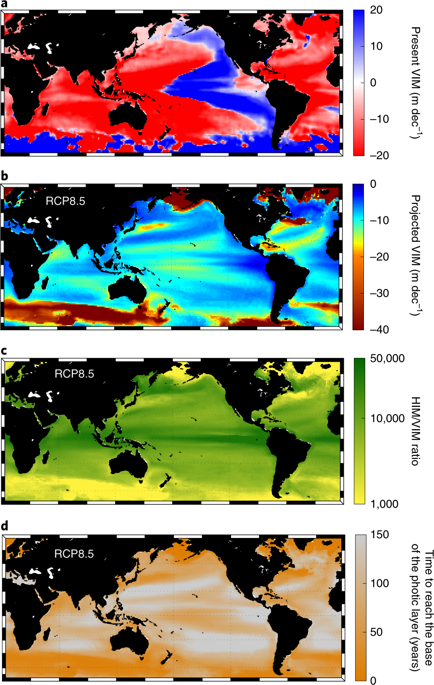当前位置:
X-MOL 学术
›
Nat. Ecol. Evol.
›
论文详情
Our official English website, www.x-mol.net, welcomes your
feedback! (Note: you will need to create a separate account there.)
Ocean warming compresses the three-dimensional habitat of marine life.
Nature Ecology & Evolution ( IF 13.9 ) Pub Date : 2019-12-23 , DOI: 10.1038/s41559-019-1058-0 Gabriel Jorda 1, 2 , Núria Marbà 1 , Scott Bennett 1 , Julia Santana-Garcon 1 , Susana Agusti 3 , Carlos M Duarte 3
Nature Ecology & Evolution ( IF 13.9 ) Pub Date : 2019-12-23 , DOI: 10.1038/s41559-019-1058-0 Gabriel Jorda 1, 2 , Núria Marbà 1 , Scott Bennett 1 , Julia Santana-Garcon 1 , Susana Agusti 3 , Carlos M Duarte 3
Affiliation

|
Vertical migration to reach cooler waters is a suitable strategy for some marine organisms to adapt to ocean warming. Here, we calculate that realized vertical isotherm migration rates averaged -6.6 + 18.8 m dec-1 across the global ocean between 1980 and 2015. Throughout this century (2006-2100), surface isotherms are projected to deepen at an increasing rate across the globe, averaging -32.3 m dec-1 under the representative concentration pathway (RCP)8.5 'business as usual' emissions scenario, and -18.7 m dec-1 under the more moderate RCP4.5 scenario. The vertical redistribution required by organisms to follow surface isotherms over this century is three to four orders of magnitude less than the equivalent horizontal redistribution distance. However, the seafloor depth and the depth of the photic layer pose ultimate limits to the vertical migration possible by species. Both limits will be reached by the end of this century across much of the ocean, leading to a rapid global compression of the three-dimensional (3D) habitat of many marine organisms. Phytoplankton diversity may be maintained but displaced toward the base of the photic layer, whereas highly productive benthic habitats, especially corals, will have their suitable 3D habitat rapidly reduced.
中文翻译:

海洋变暖压缩了海洋生物的三维栖息地。
垂直迁移以到达较冷水域是一些海洋生物适应海洋变暖的合适策略。在这里,我们计算出1980年至2015年期间,全球海洋上的实际垂直等温线迁移率平均为-6.6 + 18.8 m dec-1。在本世纪(2006-2100年),预计全球地表等温线将以越来越高的速率加深,在代表性浓度途径(RCP)8.5“一切照旧”排放情景下平均为-32.3 m dec-1,在较温和的RCP4.5情景下平均为--18.7 m dec-1。在本世纪中,有机体遵循表面等温线所需的垂直重新分布比等效的水平重新分布距离小三到四个数量级。然而,海底深度和光层深度对物种可能的垂直迁移构成了最终限制。到本世纪末,海洋的大部分区域都将达到这两个极限,从而导致全球范围内许多海洋生物的三维(3D)生境迅速压缩。浮游植物的多样性可以维持,但会移向光层的底部,而高产的底栖生境,特别是珊瑚,其合适的3D生境将迅速减少。
更新日期:2019-12-23
中文翻译:

海洋变暖压缩了海洋生物的三维栖息地。
垂直迁移以到达较冷水域是一些海洋生物适应海洋变暖的合适策略。在这里,我们计算出1980年至2015年期间,全球海洋上的实际垂直等温线迁移率平均为-6.6 + 18.8 m dec-1。在本世纪(2006-2100年),预计全球地表等温线将以越来越高的速率加深,在代表性浓度途径(RCP)8.5“一切照旧”排放情景下平均为-32.3 m dec-1,在较温和的RCP4.5情景下平均为--18.7 m dec-1。在本世纪中,有机体遵循表面等温线所需的垂直重新分布比等效的水平重新分布距离小三到四个数量级。然而,海底深度和光层深度对物种可能的垂直迁移构成了最终限制。到本世纪末,海洋的大部分区域都将达到这两个极限,从而导致全球范围内许多海洋生物的三维(3D)生境迅速压缩。浮游植物的多样性可以维持,但会移向光层的底部,而高产的底栖生境,特别是珊瑚,其合适的3D生境将迅速减少。











































 京公网安备 11010802027423号
京公网安备 11010802027423号